Late Byzantine AE, 1059-1204 (Constantine X to the fall of Constantinople to the crusaders)
(Go to the main page)
John I (969-975) initiated a 120-year period of "anonymous folles" with Christ or Mary on the obverse and without the emperor's name. These coins have their own page here. Near the end of that period emperors began issuing both anonymous and "named" coppers. Constantine X (1059-1067) was the first emperor to issue both.
The Byzantine historian Psellus worked alongside Constantine X and liked his personal characteristics such as modesty, but noted he was very poor at working with the army to protect the empire from threats on all sides.
 Eudοcia (on the left!) and Constantine X, 1059-1067.
Eudοcia (on the left!) and Constantine X, 1059-1067.
28-25 mm. 10.93 grams.
Christ seated on footstool,
+ЄMMANOVΛ, often blundered
The reverse legend is supposed to be something like
+KWN Τ AK ЄVΔK AVΓO
(Constantine and Eudocia Augusti) but rarely is any of it visible.
Sear 1853.
Grierson [DO 3.1, p. 110] notes this is the only type in which two figures have the senior on the right. He notes that their outside hands on their torsos is a gesture of reverence which suggests the standard in the middle is representing Christ who is there (in spirit), in which case the senior (Christ) is in the middle, with the second (Constantine X) on the right and the third (Eudocia) on the left, as normal.
This type is usually overstruck so badly that the undertype is identifiable.

Constantine X and Eudocia
31-26 mm.
overstruck on a Class D or E follis, with the reverse
slanted from 8:00 to 2:30:
ISXS (JesuS ChristuS)
bASILE (king of)
bASIL (kings)
Some of the reverse lettering is visible:
[from 7:00:] ЄVΔ K AVΓO
but the reverse had obliterated the undertype's obverse.
Overstrikes like this one show Class D must be at latest at the time of Constantine X.
Romanus IV was the second emperor to issued both anonymous and named folles.
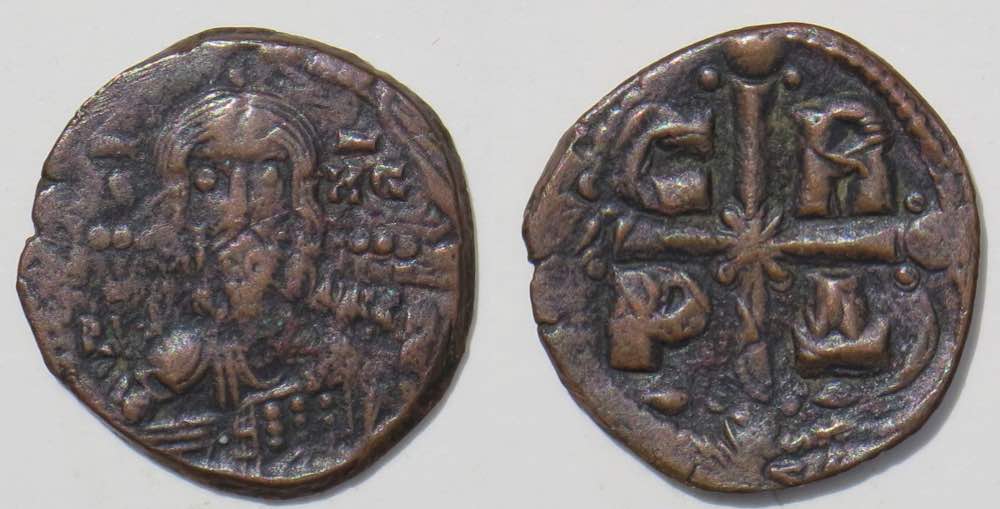 Romanus IV, 1068-1071
Romanus IV, 1068-1071
25 mm. 5.51 grams
The coin has the same facing bust of Christ found on anonymous folles, but the reverse has
C R
P Δ in the quadrants of a cross (with an X at the center)
for
Stavre Boethei ["C" is a lunate sigma for "S". "R" is an epigraphical form of "B"]
Romano Despote
"O cross protect Romanus emperor"
Sear 1866
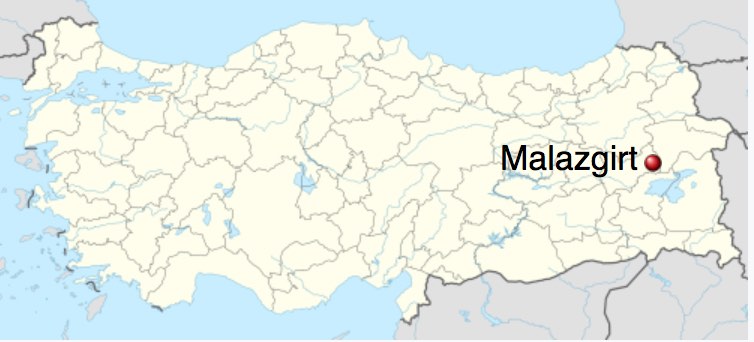
Romanus tried to defend Asia Minor against the Seljuk Turks. At the famous and disasterous Battle of Manzikert (aka Malazgirt) in 1071 he lost a large army and was captured [map from Wikipedia]. Although Romanus was released after only a week by the Seljuk Turks after signing a treaty with them, by the time he got back Michael VII, a young son of the previous emperor Constantine X, had been elevated and Romanus was blinded upon his return and died shortly thereafter (no antibiotics!).
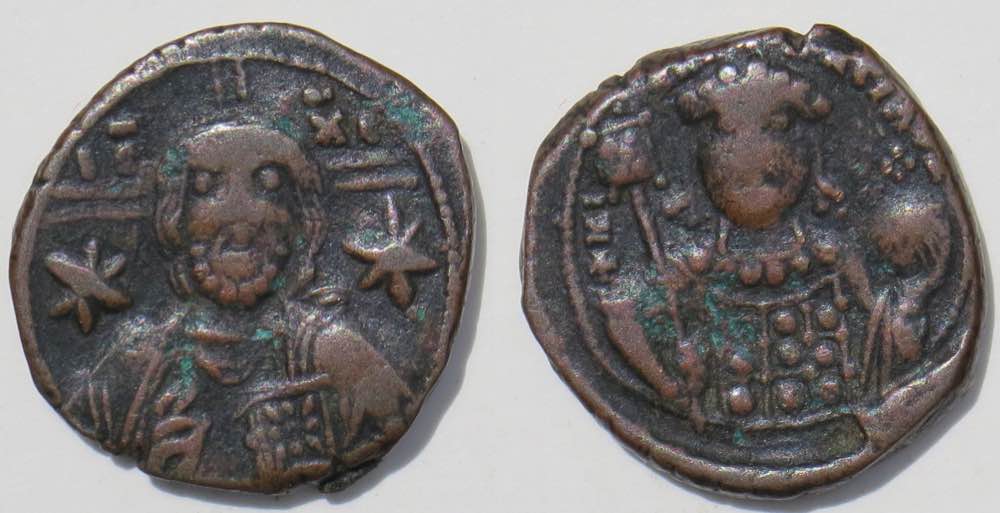 Michael VII, Ducas, 1071-1078
Michael VII, Ducas, 1071-1078
25 mm. 9.63 grams (heavier and thicker than most).
Bust of Christ, star either side, holding gospels in left and giving a sign of blessing with his right.At 9:00 the beginning of his name is visible:
+MI XAHΛ RACIΛ ΟΔ
Sear 1878
Nicephorus III, 1078-1081. Michael VII was easily overthrown by Nicephorus III (1078-1081) and forced to retire to a monestery. To add to his legitimacy, Nicephorus married Michael's wife. Some anonymous folles ["Class I"] have been attributed to him. He has one other follis type that is not anonymous, Sear 1888. It is quite scarce (although low-valued in Sear) and rarely comes at all nice (remember, we are discussing Byzantine copper). The Sear plate coin is not pleasing--the photograph is hard to decipher.
 [Repeated from the previous page] Nicephorus III, 1078-1081.
[Repeated from the previous page] Nicephorus III, 1078-1081.
23-22 mm. 5.55 grams.
Christ standing facing, IC XC either side, eight-pointed stars below, either side.
C Φ
N Δ
in quadrants of cross with big dot at each end. Eight-pointed star in circle.
According to Whitting, Byzantine Coins, the letters abbreviate
May the cross (C) protect (Φ)
Nicephorus (N) emperor (Δ) [Despot]
Expanded: CΦNΔ = Σταυρέ Φύλαττε Νικήφορον Δεπότη
O Cross, protect Nikephoros Emperor/Despotate
Sear 1888.
Alexius I, 1081-1118. Alexius I was the last emperor to issue anonymous folles. He founded a dynasty lasting a century in which the first three rulers all had long reigns. Alexius reformed the coinage in 1092. The follis was discontinued. New denominations were introduced including cup-shaped concave coins in three denominations, a gold "hyperpyron" ("super-refined," also called by the Byzantines simply "the gold coin") about 20 1/2 carats fine, an electrum (a gold-silver alloy) "one-third hyperpyron" about 6 carats fine, and a billon (base silver) trachy of about 6 or 7 percent silver. Below that were two small copper denominations, the tetarteron and half-teterteron. (Continued below after a digression about gold coins.)
Note: Decades ago numismatists used the term "scyphate" for cup-shaped coins, but further research showed the word (of Arabic derivation) really refers to the rim of the silver miliaresion with its distinguishing three-circles and had nothing to do with not being flat. The word "trachy" (plural: trachea) meaning "rough" or "uneven" and then "not flat" is the right Byzantine word for "cup-shaped."
Precious Metals. Coinage in precious metals was complicated prior to the reform of Alexius I. There were two gold denominations, not much different from each other. One was a full-weight "histamenon" (= "standard") and the other a slightly lighter "tetarteron" about 8 carats fine. There were few silver miliaresia or its fractions. Under Constantine IX (1042-1055) the histamenon was for the first time stuck concave to distinguish it from the tetarteron. The amount of gold in the "gold" coins declined noticeably over time so the contemporary documents sometimes name the denomination using the name of the emperor on the coin because often coins of earlier emperors had more gold and were worth distinguishing in value from coins of the current emperor.
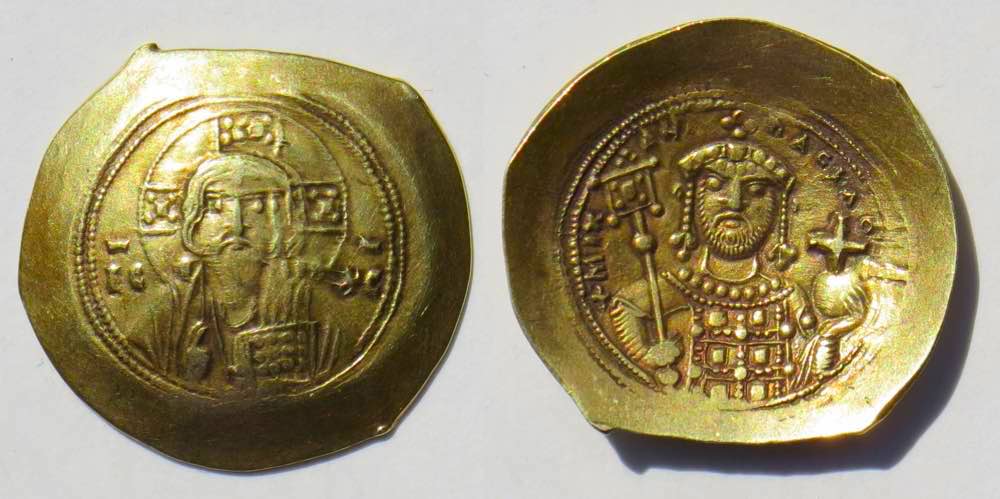
Michael VII, 1071-1078
Gold. 28 mm. 4.24 grams.
This coin looks like good gold, but gold is so valuable that every carat of fineness makes a significant difference. Could you tell if this is 24 carat, 20 carat, 18 carat, 14 carat, or something in between, or less?
Sear 1868
Note: The Byzantine Empire lasted a very long time. We cannot really expect coins and metal composition to remain constant over hundreds of years. A sale catalog might have numerous Byzantine gold coins and yet consecutive coins in the catalog might be dated 50 or 100 years apart. For emperors with long reigns even coins of the same type could be issued 20 or 30 years apart, with their fineness having declined in the interval. It is no wonder it is hard to pick a name for precious-metal denominations when names attested in Byzantine times changed frequently. If a gold new coin type is similar in shape to an old one, but debased a bit more, is it still the same denomination? Maybe it is to us as collectors, but it was not to the Byzantine person using or saving it as a certain amount of gold.
Debasement. Over the centuries the amount of gold in "gold" coins declined.
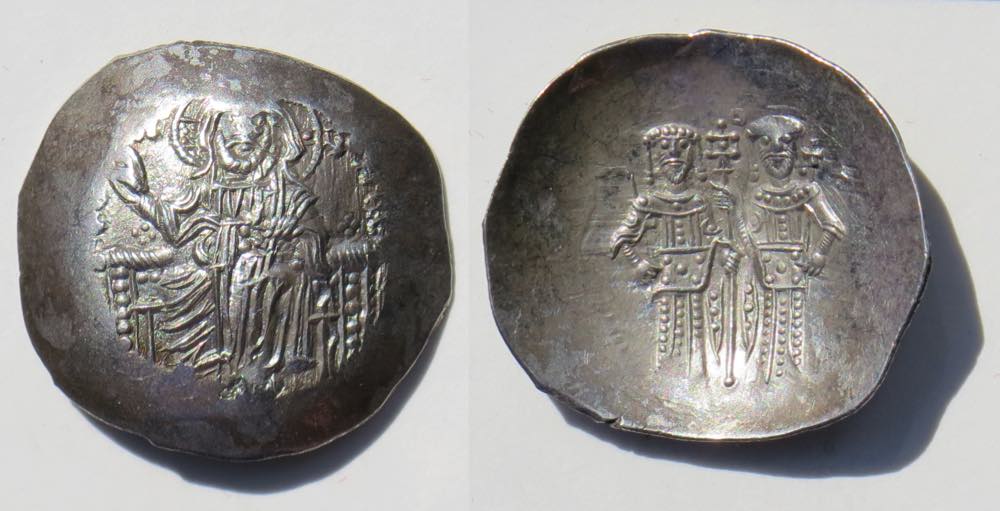
Alexius III, 1195-1203
White electrum. 29-27 mm. 4.49 grams.
Sear 2010
This is a direct descendant of gold coins.
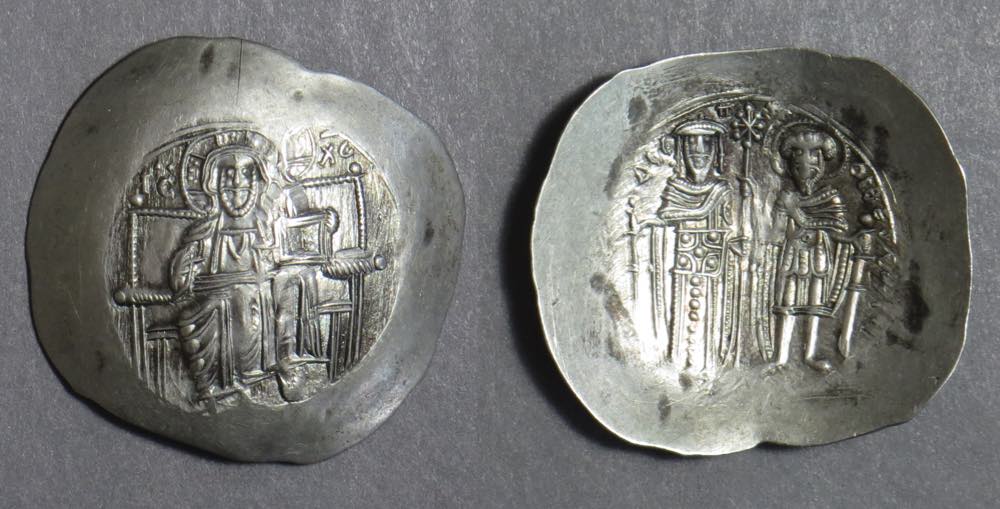
Theodore I, Empire of Nicaea, 1208-1221
Silver 33-30 mm. 4.27 grams.
Sear 2064
Eventually, when the gold content is small enough, it is fair to call coins "silver" instead of "electrum". It takes sophisticated chemical analysis to know how much gold is in a coin type.
Alexius I, Comnenus (1081-1118). In the late Empire power shifted away from the army to great landowning families with vast wealth. They intermarried and preserved and enhanced their power. Two of the families are the Comnenus family and the Ducas family.
The first three Comneni are Alexius I (1081-1118, John II (1118-1143), and Manuel I (1143-1180).

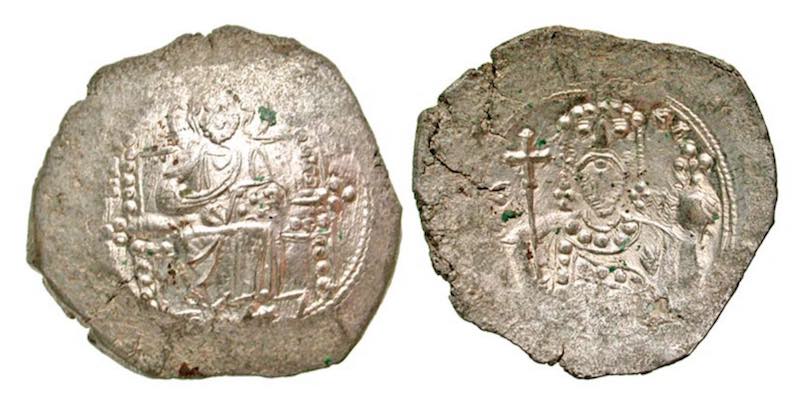 Alexius I, 1081-1118
Alexius I, 1081-1118
26-24 mm. 4.28 grams.
Billon trachy with unusually good silver
Christ seated facing
Emperor facing
Sear 1918.
DOC IV 25 Constantinople 1093-1118. i.e. after his coin reform.
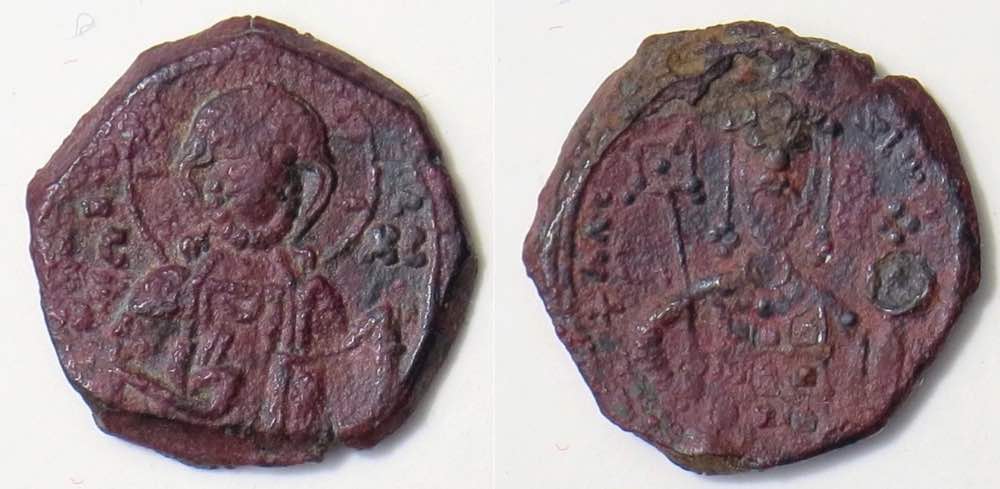 Alexius I, 1081-1118
Alexius I, 1081-1118
18 mm. 3.94 grams.
Tetarteron
Christ facing, IC XC
Emperor facing, holding labarum and globus cruciger
AΛЄ up left for ALExius.
Sear 1920.
Unlike the previous centuries when each emperor had only one or a few AE types, Alexius I has a dozen types of tetartera.
Here is an off-site map of Europe in AD 1100. (The Byzantine Empire is in pink. The empire includes much of the Balkans and much of modern Turkey, but the central part of Turkey has been lost.)
Here is a page on the coin reform of Alexius.
John II, 1118-1143.
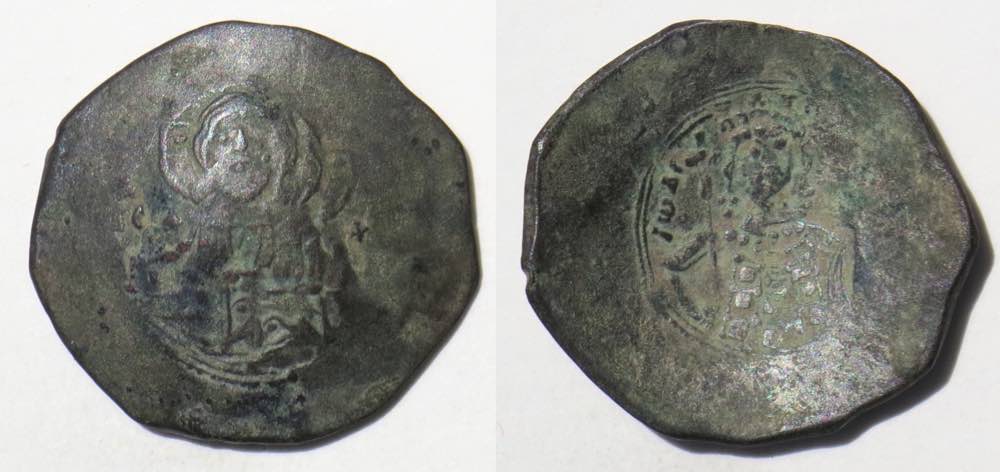 John II, 1118-1143
John II, 1118-1143
30-28 mm. 4.61 grams.
Billon trachy.
Bust of Christ
1/2 length bust of John
IWA up left beginning IOAHANNES (John)
Sear 1944
Billon Trachy. Cup-shaped billon trachy were struck with a very low silver content so most look like copper. The tetrateron really was copper and worth far less because the intrinsic value of silver was about 100 times that of copper, so a trachy with, say 4% silver would be worth 5 times what a copper coin of the same weight would be worth, not counting the fact that trachy were larger.
As usual, part of this is double struck slightly out of line. Look at the eyes of John and the top of his head which show doubling. Apparently trachy were struck twice, once emphasizing the left and once emphasizing the right, and it is typical for the two strikes not to line up perfectly at the center. Finding one of these without doubling and with a clear bust of Christ and good details on the reverse is difficult.
John also struck copper tetartera and half-tetartera.
 John II, 1118-1143
John II, 1118-1143
19-16 mm. 3.22 grams.
Tetarteron. This denomination is struck flat.
Christ standing
Emperor standing
Sear 1945
The half-tetarteron denomination looks similar, but is slightly smaller in diameter.
Manuel I, Comnenus (1143-1180). Manuel ruled a long time. His coins are very common, both as trachea and tetartera.
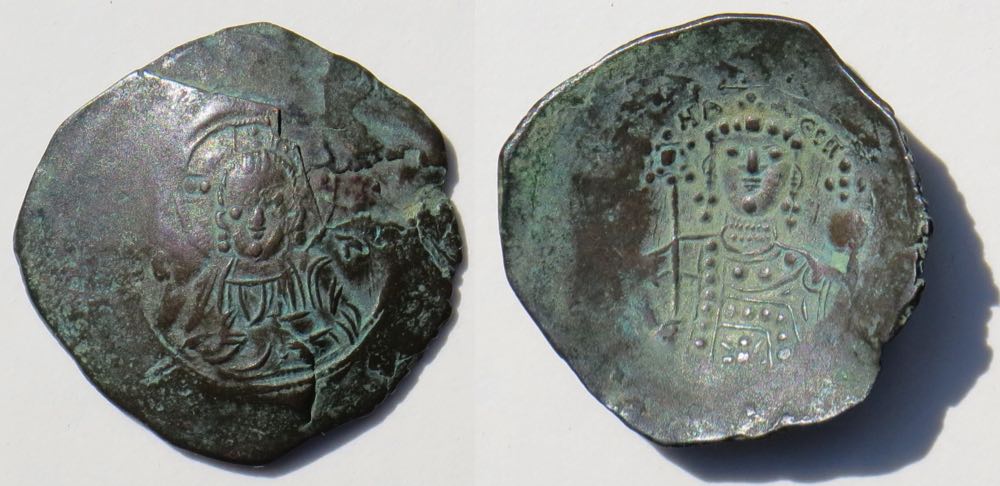 Manuel I, 1143-1180
Manuel I, 1143-1180
29 mm. 3.24 grams.
Trachy
Bust of Christ
Bust of Manuel
(at 11:00 you can see "HΛ" for the end on Manuel (the "H" is a Greek eta) continued by "ΔЄCΠ" for "Despot" = emperor.
Sear 1962
Trachea of Manuel I are common, but only a small fraction have the reverse legend clear enough to give his name.
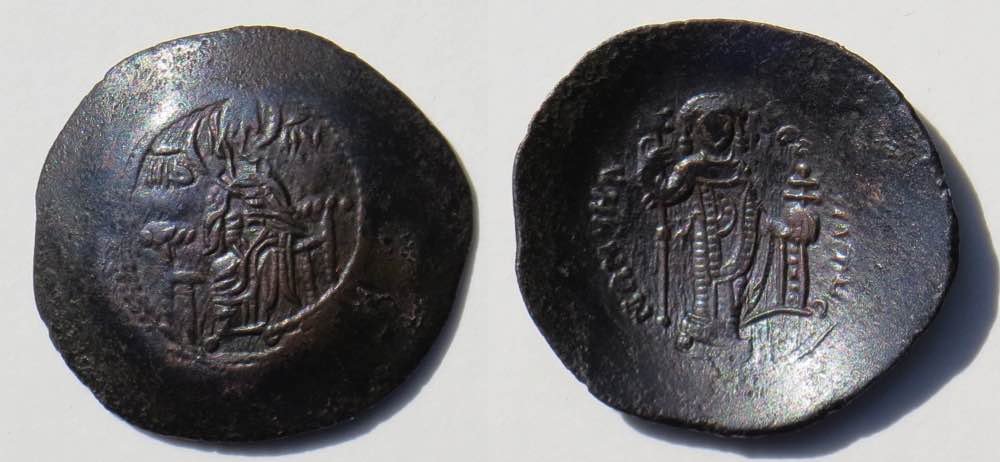
Manuel I, 1143-1180
Struck c. 1160-1164
28 mm. 3.34 grams.
TrachyBust of Virgin Mary MP ΘV across field (Mother of God, abbreviated)
Standing figure of Manuel I
MANɣHΛ ΔЄCΠOTHC (Manuel, Despot)
Sear 1964
This remarkably fine strike gives it at least a five-fold premium.
 Manuel I, 1143-1180
Manuel I, 1143-1180
21 mm. 4.85 grams.
Tetarteron
Bust of Christ
Bust of Manuel
Sear 1975
Some tetartera of Manuel (e.g. this type) come in high grade.
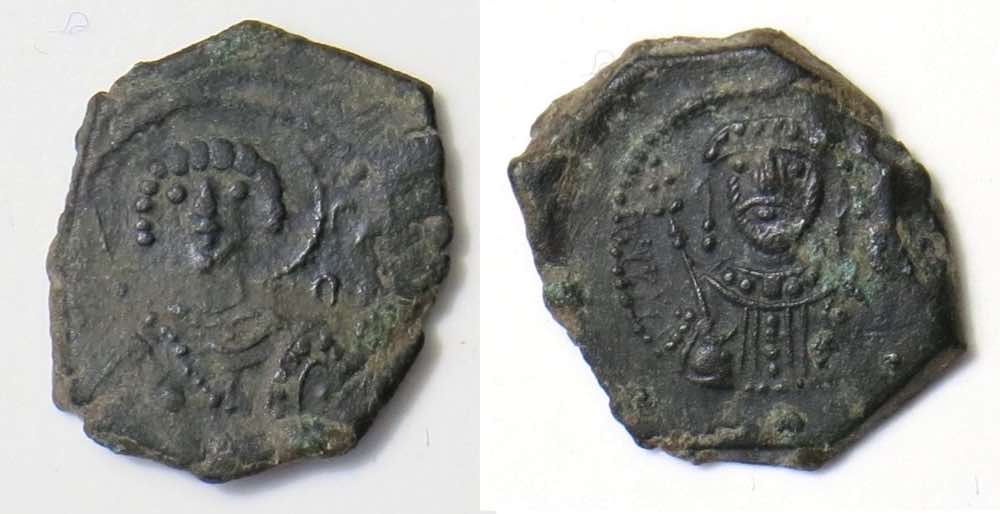 Manuel I, 1143-1180
Manuel I, 1143-1180
17-14 mm. 2.27 grams.
Half-tetarteron
same design as above
Sear 1980
The tetarteron above is larger than most and it is distinctly larger than this half. But, their designs are the same making it difficult to distinguish a large half from a small full.
Andronicus I, Comnenus, 1183-1185.
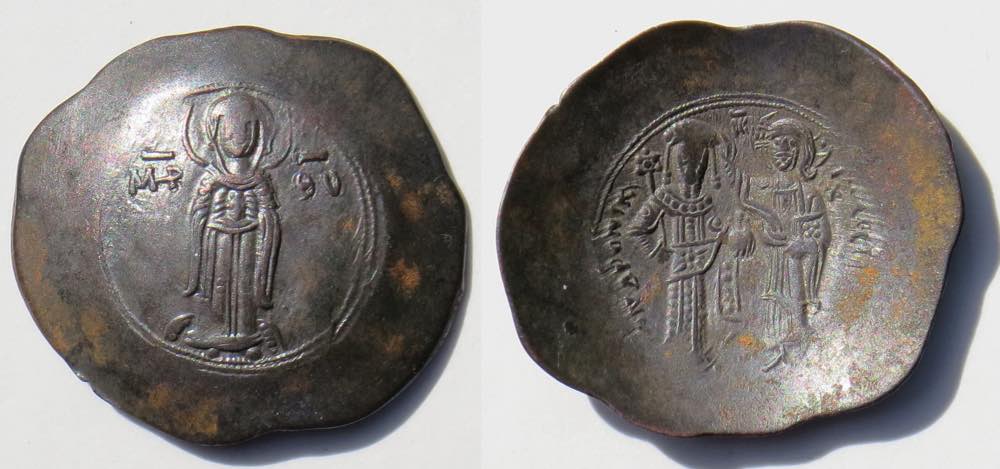 Andronicus I, 1183-1185.
Andronicus I, 1183-1185.
31-29 mm. 4.06 grams. Billon aspron trachy.
MP ΘV (Mother of God) Virgin standing.
ANΔPONIK IC IΔЄC
Andronicus on left being crowned by Christ
Sear 1985
Remarkably fine condition.
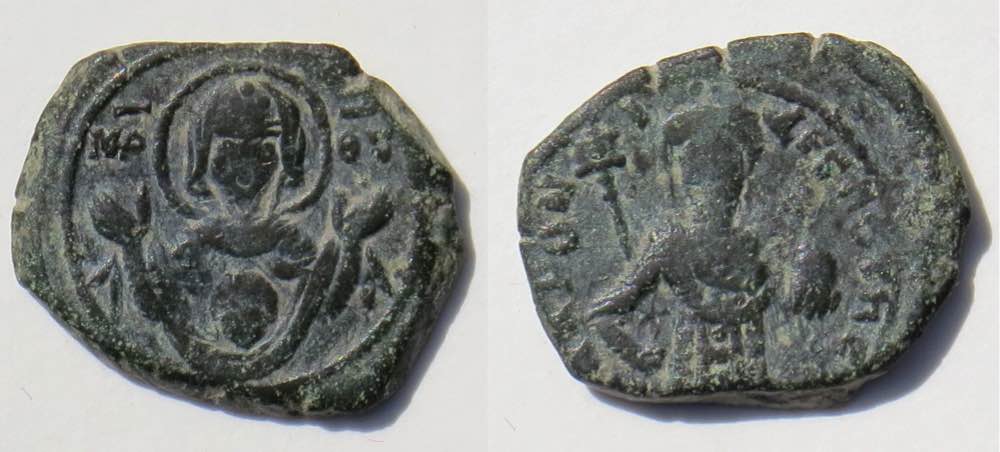 Andronicus I, 1183-1185
Andronicus I, 1183-1185
21-17 mm. Tetarteron.
MP ΘV (Mother of God) Facing bust of Virgin, orans, with bust of Christ on her breast
ANΔPON - I - ΔЄSΠOTHC
Sear 1987 (variety with "Despot")
Isaac II, Angelus, 1185-1195.
 Isaac II, 1185-1195
Isaac II, 1185-1195
29 mm. 4.88 grams. Billon aspron trachy.
MP ΘV (Mother of God) Virgin enthroned.
emperor standing, facing.
His name, illegible, to left.
ΔЄCΠOTHC to right.
Isaac Comnenus, Usurper in Cyprus, 1185-1191.
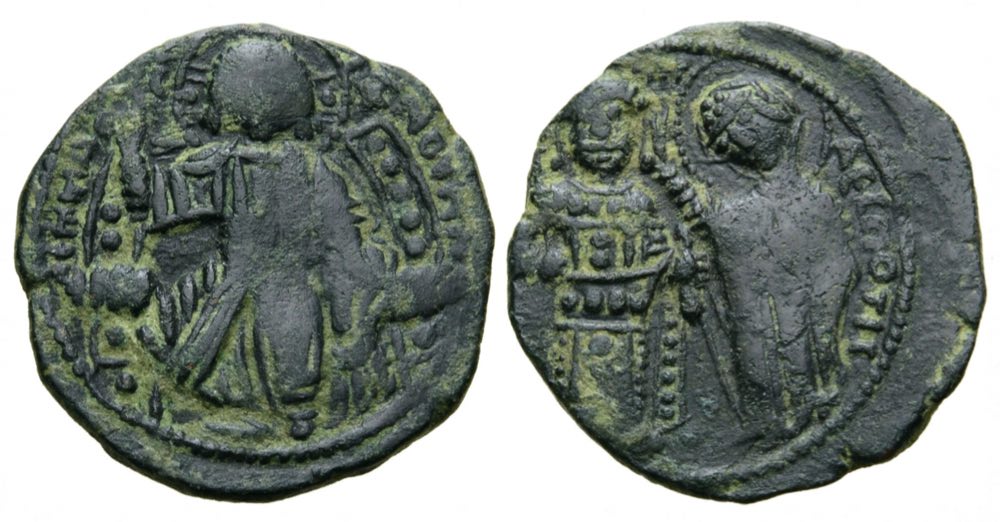
Tetarteron. 19 mm. 3.60 grams.
Christ pantocrator, enthroned. EMMA NOV...
Virgin, nimbate, crowning the emperor.
ΙICAAKOC [off the flan to the left] DECPOTIC to right.
Sear 1998. DOC 4.1, #10, page 363 and 4.2 plate XIX.
For his story, see my page here (It links back to this place on this page, so you can easily return.)
Alexius III, Angelus-Comnenus, 1195-1203.
 Alexius III, 1195-1203
Alexius III, 1195-1203
27-25 mm. 3.41 grams. Billon trachy.
Bust of Christ, nimbate
Alexius standing on left, St. Constantine on right.
Sear 2012
This trachy is fairly well-struck in the middle, at the cost of lacking the legends to the left and right which name Alexius Despot.
Any billon trachy that has all intended detail with no apparent double strike is very unusual indeed.
Here is an off-site map of Europe in AD 1200. (The Byzantine Empire is in pink. The empire includes only the Balkans and the coasts of Asian Turkey, but not the interior of Turkey.)
The Fourth Crusade. The Fourth Crusade was called by the Catholic Pope in 1202 with the intent to recover Egypt and then Jerusalem from the Muslims. However, they had insufficient funds to pay Venice for transport and paid part by sacking Zara, a Catholic city in Croatia, instead. A Byzantine prince, Alexios IV, Angelus, promised to pay the Crusaders if they would go to Constantinople and put his father Isaac II, back on the throne (even though he had been blinded), which would put Alexius IV next in line. Crusaders outside the walls in August 1203 caused Alexius III to flee the city and the Crusaders restored Isaac II along with Alexius IV, who got what he wanted, but not for long. The treasury was unable to pay what Aleius had promised, so in January 1204 they were overthrown and in February the Crusaders decided to conquer the city. Although Constantinople had withstood all attacks for nine centuries, the resources of the empire were not what they had once been and it fell in April to an orgy of massacre and destruction.
The Latin Rulers of Constantinople. From 1204 to 1261 the Latin Crusaders ruled Constantinople. They issued coins that are poor relations of the already poor Byzantine trachea.
Continue with the next page on coins of the Latin rulers of Constantinople and later Byzantine coins, 1204-1453.
 Eudοcia (on the left!) and Constantine X, 1059-1067.
Eudοcia (on the left!) and Constantine X, 1059-1067.
 Romanus IV, 1068-1071
Romanus IV, 1068-1071

 [Repeated from the previous page] Nicephorus III, 1078-1081.
[Repeated from the previous page] Nicephorus III, 1078-1081.


 Alexius I, 1081-1118
Alexius I, 1081-1118 Alexius I, 1081-1118
Alexius I, 1081-1118 John II, 1118-1143
John II, 1118-1143 John II, 1118-1143
John II, 1118-1143 Manuel I, 1143-1180
Manuel I, 1143-1180
 Manuel I, 1143-1180
Manuel I, 1143-1180 Manuel I, 1143-1180
Manuel I, 1143-1180 Andronicus I, 1183-1185.
Andronicus I, 1183-1185. Andronicus I, 1183-1185
Andronicus I, 1183-1185 Isaac II, 1185-1195
Isaac II, 1185-1195
 Alexius III, 1195-1203
Alexius III, 1195-1203